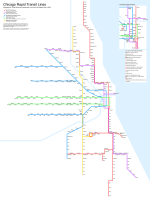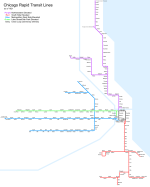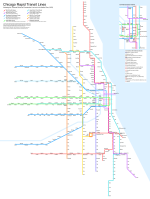Now to the real reason I started drawing Chicago - some past plans.
The system that existed in 1921 had been largely built in the 1890s - the Northwestern Elevated opened its branch to Ravenswood in 1907, and after the four companies pooled their operations in the Chicago Elevated Railways Collateral Trust (CER) in 1911, focus was placed on improving service and increasing connectivity between the different lines rather than extending the system. Which, considering Chicago doubled in population from one to two million between 1890 and 1910 and reached 2.7 million by 1920, was beginning to pose a problem. Especially so considering the city's growth was mainly in the form of outward expansion rather than densification, with new suburbs springing up like mushrooms around the city.
The city fathers were acutely aware of this, and after World War I they appointed Rudolph Frederick Kelker, an engineer who worked for the city's transportation committee, to draw up a plan for how Chicago's public transportation system could be extended and modernised to meet the needs of a growing city. Kelker's plan, which was published in 1923 under the unwieldy title
Report on a Physical Plan for a Unified Transportation System for the City of Chicago (it's usually just called the "Kelker Plan"), called for the rapid transit and surface (streetcar) systems to be unified under a single operator, ideally owned by the city, as well as a large program of extensions to both systems that would bring service to new parts of the city and deal with the chronic capacity issues that already plagued the Union Loop twenty-five years after its opening.
Kelker divided his plan into two phases: the first phase, costed at $218 million (some $3.9 billion in today's money), included measures deemed immediately necessary to meet Chicago's needs as they were in 1923, while the second phase, for a more modest $155 million ($2.8 billion today), was meant to provide for a population of five million, which was the then-projection for 1950. (It turned out that prediction was about right, except that obviously those five million people were a lot more spread out than people in 1923 imagined they'd be)
The map below shows the rapid transit system as Kelker envisioned it after the first phase of construction. Key projects include:
- A subway under State Street, starting at a portal and a connection with the South Side L around 16th street in the South Loop and proceeding north through the CBD, turning west at North Avenue and connecting to the Northwestern L around Orleans Street (just east of Sedgwick station, quite a bit south of where OTL's State Street subway connected). This was to be a two-track line except for the CBD section, which would be built with four tracks to allow for short turns if needed.
- Another subway would begin at Blue Island and Maxwell (just south of today's UIC campus), then go east along Harrison Street into the CBD, where it would run under Clark Street, two blocks west of State (and one block west of OTL's Dearborn Street subway), then turn west along Chicago Avenue at its north end and continue as an elevated up to the existing Metropolitan Elevated line at Paulina Street. More on which in a moment.
- The "Paulina Connector" (a name that would not be used for several decades), the north-south line that connected the Metropolitan L's various branches, was to be separated from it and turned into a new north-south trunk line, running along Ashland Avenue through the Southwest Side to terminate at 87th Street, and connecting to the Ravenswood branch in the north before running on its own alignment along California Avenue to terminate at Howard Street near the city limit. This would also be connected to the Stock Yards branch of the South Side L, which would make commutes much easier for all stockyard workers who didn't live immediately near that line.
- To go with the mid-city trunk, the Clark Street subway's southern leg would have two branches: one taking over the Douglas Park branch of the Metropolitan (essentially today's Pink Line), and one continuing south along Ashland, then southwest Archer Avenue, and finally south again on Kedzie, serving most of the Southwest Side's more densely-populated areas.
- In the northwest, there would be two corresponding branches built, one continuing northwest along Milwaukee Avenue and one running west on Belmont Avenue, terminating at Harlem Avenue near the western city limit. The Humboldt Park branch would also be extended west to Austin Avenue, and both it and the Milwaukee Avenue line would have a third track added to allow express service during peak hours.
- The Milwaukee Avenue L would also be extended southeast from Paulina, connecting with the Lake Street L and running into its terminal on Market Street (today's Wacker Drive). I believe Kelker also made provision for the southwestern branches to run into the Metropolitan's Wells Street terminal, but I decided the area around Ashland and Blue Island looked complicated enough without me trying to map that.
- The Ravenswood branch would be extended west along Lawrence Avenue to its intersection with Milwaukee Avenue, where both it and the Milwaukee branch would terminate.
- In lieu of the Northwestern L's North Water Street terminal, a new two-track elevated line was to be built along Austin Avenue (today's Hubbard Street), terminating at the Municipal Pier (today's Navy Pier) and allowing better service to the fast-growing Near North Side. The maps included in Kelker's report only show this line connecting to the Northwestern L from the north, so I assume that would be its only service pattern even though I assume a lot of people would want to travel from there to the CBD. Oh well.
- The South Side L's various branches would almost all be extended - the Stock Yards branch has already been mentioned, but the Kenwood branch would be extended west to meet both the Southwest Side lines and terminate at Kedzie, while the Jackson Park branch would be extended south to 93rd Street along Stony Island and South Chicago Avenues (fun fact: because of how Chicago's street grid works, South Chicago Avenue's street addresses take the format "XXXX South South Chicago Avenue"). A new branch would also be constructed running due south from 61st Street station and terminating at 127th Street. To provide adequate service for all these new extensions, the main line of the South Side L was to be expanded to four tracks, and a new terminal built at Wabash and Van Buren.
- Finally, although Kelker (almost uniquely for Chicago transit planners before about 1990) didn't call for the Loop itself to be demolished, he did want its western leg along Wells Street to be grade-separated from the rest of it, and a short new alignment built south along Wells to Polk and then east to connect to the South Side L. This would allow two alternate two-track routes running north-south through the CBD, effectively creating a four-track corridor all the way from Howard to 61st, and a separate alignment for the "West Side Group" of lines, i.e. the Lake Street and Metropolitan main lines, which Kelker envisioned forming one of the four key trunks of the network.

So what parts of this were actually built? Well, not a lot. The State Street subway, along with a subway under Dearborn Street and Milwaukee Avenue that more-or-less parallelled Kelker's Clark Street corridor, were both built in the 1940s, though the latter didn't open until 1951 due to wartime construction stoppages, and the Southwest Side did finally obtain L service in 1993 when the Orange Line opened. And right now, as I write this, the CTA is in the advanced stages of planning for an extension to bring the Red Line down to 130th Street, an extension Kelker deemed immediately necessary a full century ago.
There have also been a lot of outright closures, some probably necessary due to slow and outdated infrastructure, but often also dealing serious damage to communities served. After World War II, Chicago's innermost suburbs would be severely blighted by freeway construction and "slum clearances" that left behind an urban wasteland, and it didn't help when the CTA axed stops in the name of bringing suburban commuters into the city slightly faster, or moved entire lines from busy commercial arteries into the middle of freeways designed to avoid points of density.






